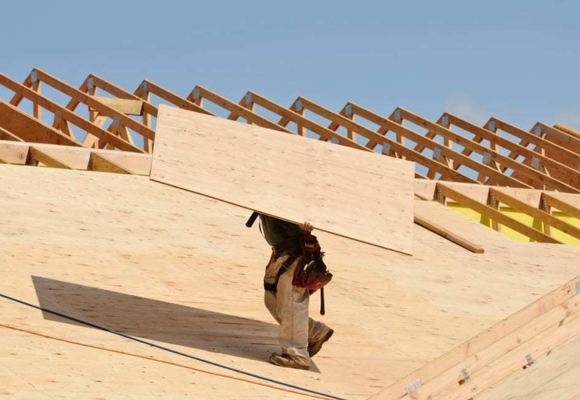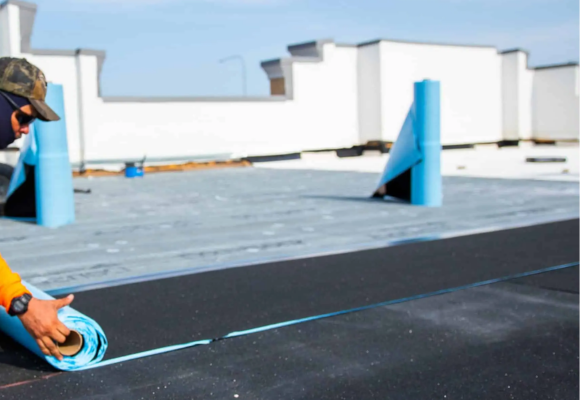Ensuring compliance with local regulations and obtaining the necessary permits is crucial for home improvement projects.
One such project that often requires a permit is roof replacement or repair. Homeowners may wonder if they can pull a roofing permit themselves or if it is solely reserved for professional contractors.
This comprehensive guide will delve into homeowners pulling roofing permits and exploring the associated requirements, regulations, and processes.
By the end, you’ll clearly understand whether you, as a homeowner, can take the reins and navigate the permit process confidently.
What Happens If You Do a Roof Without a Permit?
Undertaking a roof replacement or repair without obtaining the required permit can lead to various potential consequences.
While the specifics may vary depending on your location, it is essential to know the general risks involved.
Here are some potential outcomes of proceeding without a roofing permit:
1. Legal Issues: Performing roofing work without a permit typically violates local building codes and regulations.
This can result in legal complications and potential fines or penalties. Authorities may issue a “stop work” order, halting the project until the necessary permits are obtained.
2. Safety Concerns: Without proper oversight, the quality and safety of the roofing project may be compromised.
Permits ensure that the work meets established standards, such as structural integrity and adherence to fire safety codes.
A lack of oversight can lead to potential hazards for occupants and future property buyers.
3. Insurance Coverage: Insurance companies may refuse to cover damages or accidents resulting from work performed without the required permits.
In the event of a roofing-related incident, you may be held liable for any costs or damages, putting your financial well-being at risk.
4. Property Value and Resale: Unpermitted work can affect the value and marketability of your property.
Prospective buyers may hesitate to purchase a home with undocumented or non-compliant renovations.
Additionally, if discovered during a property inspection, unpermitted work can complicate the selling process or require corrective actions.
Roofing Permit Requirements
Obtaining a roofing permit typically involves fulfilling certain requirements set by local authorities.
While specific requirements may vary depending on your location, here are some common aspects to consider when applying for a roofing permit:

a. Documentation: Prepare the necessary documentation before applying for a permit.
This may include project plans, specifications, and supporting documents demonstrating building codes and regulations compliance.
b. Application Form: Obtain the official application form from your local building department or permit office.
Fill out the form accurately, providing all requested information, such as property details, project scope, and estimated timeline.
c. Fee Payment: Most permit applications require a fee payment covering processing and inspection costs.
The fee amount can vary depending on the scope and value of the roofing project. Contact your local building department to determine the specific fee structure.
d. Contractor Information: If you’re hiring a professional roofing contractor, you may need to provide their license information and proof of insurance as part of the permit application.
Some areas require contractors to hold valid licenses and carry liability insurance.
e. Inspections: As part of the permit process, inspections are typically conducted at various stages of the roofing project.
Inspectors will assess the work for compliance with building codes, safety standards, and quality requirements. It is essential to schedule and pass all required inspections to ensure project approval.
f. Timelines: Keep in mind that permit processing times can vary depending on your location and the workload of the local building department.
Factor in this timeframe when planning your roofing project to ensure a smooth process from start to finish.
Do You Need a Permit for Roof Replacement?
One common question homeowners have is whether a permit is required for roof replacement.
The answer depends on various factors, including local building codes and regulations. Here are some considerations:

1. Local Regulations: Different jurisdictions have different rules regarding roof replacement permits. Some areas may require a permit for any roof replacement.
In contrast, others may exempt certain situations, such as when the replacement involves a similar material or does not alter the roof’s structural integrity.
2. Material and Scope: Permit requirements may vary based on the roofing material and the project’s scope.
For example, replacing asphalt shingles with a similar material may be exempt from permits in some areas.
However, a permit is likely required if you plan to change the roofing material or undertake extensive structural modifications.
3. Historic Districts or HOA: If your property is located in a historic district or governed by a homeowner’s association (HOA), additional regulations may come into play.
These entities often have guidelines and approval processes for exterior modifications, including roof replacements.
To determine whether a permit is needed for your roof replacement, it is best to consult with your local building department or permit office.
They can provide specific information regarding permit requirements based on your location and project details.
Roofing Permit Regulations in California
If you reside in California, it’s essential to understand the specific roofing permit regulations in the state.
California has its own set of guidelines and requirements for obtaining a roofing permit. Here are some key points to consider:

1. State and Local Codes: California has adopted the California Building Code (CBC) statewide standard. However, local jurisdictions within the state may have additional regulations or amendments to the CBC that you must adhere to.
It’s crucial to consult with your local building department to understand the specific codes applicable to your area.
2. Energy Efficiency Requirements: California has stringent energy efficiency standards known as Title 24.
When replacing or installing a new roof, you may need to comply with these requirements, including insulation, ventilation, and cool roofing materials.
Ensure your roofing project aligns with the state’s energy efficiency guidelines.
3. Fire Safety Considerations: Due to the risk of wildfires in certain regions of California, fire safety regulations play a significant role in roofing projects.
Depending on your location, you may need to use fire-resistant roofing materials or comply with specific fire-rated construction requirements.
Awareness of any fire safety provisions that apply to your area is crucial.
4. Permit Application Process: The process of applying for a roofing permit in California may vary from one jurisdiction to another.
You must complete an application form, provide project details, submit the necessary documentation, and pay the required fees.
Your local building department can guide you through the steps and paperwork involved.
5. Inspections and Compliance: As part of the permit process, inspections will ensure compliance with the applicable codes and regulations.
Inspectors will assess the quality of workmanship, structural integrity, fire safety measures, and energy efficiency aspects.
Cooperate with the inspectors and address any identified issues to ensure project approval.
To ensure a smooth roofing permit process in California, you must familiarize yourself with the statewide building codes and the specific regulations enforced by your local jurisdiction.
By adhering to these guidelines, you can ensure that your roofing project meets the necessary standards and contributes to the safety and sustainability of your property.
How Much Is a Roofing Permit?
The cost of a roofing permit can vary depending on several factors, including the location, the scope and value of the roofing project, and the specific fees set by the local building department.
Here are some considerations regarding the cost of a roofing permit:

a. Local Fee Structure: Each jurisdiction has its fee structure for building permits, including roofing permits.
The fees may be based on the project’s valuation or calculated using a predetermined schedule.
Contact your local building department to inquire about the specific fee requirements for obtaining a roofing permit in your area.
b. Project Complexity and Size: The complexity and size of the roofing project can impact the permit fees.
A larger or more intricate project may require additional inspections and administrative resources, leading to higher permit costs.
c. Additional Requirements: In some cases, additional requirements or fees may be associated with roofing permits.
For example, certain jurisdictions may require separate fees for plan reviews, fire safety compliance, or energy efficiency assessments. Be sure to inquire about any additional requirements affecting the overall permit cost.
d. Contractor Fees: If you’re hiring a professional roofing contractor to perform the work, their fees may include obtaining the permit on your behalf.
Discuss this with the contractor to clarify if the permit fees are included in their pricing or if they will be billed separately.
While the exact cost of a roofing permit cannot be determined without consulting your local building department, it’s important to budget for this expense when planning your roofing project.
Obtaining the necessary permits ensures compliance with building codes and regulations, providing peace of mind and protecting the integrity of your property.
Roofing Permit Application Process
Navigating the roofing permit application process can seem daunting, but understanding the steps involved can help streamline the procedure.
Here’s a general overview of the roofing permit application process:
1. Research and Preparation: Research the specific requirements for obtaining a roofing permit in your local jurisdiction.
Familiarize yourself with the necessary documentation, forms, and any additional information needed for the application process. This may include project plans, specifications, contractor information, and proof of insurance.
2. Application Submission: Obtain the official roofing permit application form from your local building department or permit office.
Fill out the form accurately, providing all requested details. Include comprehensive information about the roofing project, such as the scope of work, materials to be used, and estimated start and completion dates.
3. Documentation Submission: Submit any required documentation and the completed application form.
This may include project plans, engineering reports, manufacturer specifications, and proof of contractor licenses and insurance.
Ensure that all documents are clear, legible, and comply with the requirements set by the building department.
4. Fee Payment: Most permit applications involve a fee that covers processing and inspection costs.
Calculate the fee based on the valuation of your roofing project or refer to the fee schedule provided by the building department. Submit the payment along with your application.
Accepted payment methods may include cash, check, or electronic payments.
5. Review and Approval: Once your application and supporting documents are submitted, the building department will review them for compliance with building codes and regulations.
This review ensures that your roofing project meets safety and structural requirements.
You may be asked to provide additional information or revise your application if any deficiencies or issues are identified.
6. Inspections: After your application is approved, the building department will schedule inspections at various stages of the roofing project.
These inspections ensure the work progresses according to the approved plans and complies with the relevant codes and regulations.
Schedule inspections as required and notify the building department when the work is ready for inspection.
7. Final Approval and Certificate of Occupancy: Once all inspections are completed and the roofing project meets the building department’s standards, you will receive final approval.
The building department may issue a Certificate of Occupancy or a document that signifies compliance with the permit requirements. This certificate is essential for insurance purposes and future property transactions.
It’s important to note that the specific steps and requirements of the roofing permit application process may vary depending on your local jurisdiction.
Therefore, it is advisable to consult with your local building department or permit office to obtain detailed and up-to-date information about your specific area.
Roof Permit Search and Verification
Once you have obtained a roofing permit, keeping a record for future reference is crucial.
Additionally, verifying the permit’s status or checking the permits of other properties may be necessary. Here are some methods you can use to search and verify roofing permits:

a. Online Permit Search: Many local building departments offer online permit search portals where you can access permit records.
Visit your local building department’s website and look for a dedicated permit search tool or database. Enter the relevant information, such as the property address or permit number, to retrieve the permit details.
b. Permit Verification Services: Some jurisdictions collaborate with third-party providers offering permit verification services.
These services allow you to search and verify permits using parameters such as address, permit number, or property owner’s name.
Check if your local building department provides such services or recommends any trusted verification platforms.
c. Contact the Building Department: If online search options are unavailable or you encounter difficulties, contacting the local building department is reliable.
Reach out to their customer service or permit office via phone or email. Provide them with the necessary information, such as the property address or permit number, and request the permit status or any additional details you may need.
d. Physical Permit Records: Sometimes, local building departments maintain physical permit records at their office or archives.
If you prefer an in-person approach, visit the building department during business hours and request assistance searching and verifying the roofing permit.
It is essential to remember that permit records and search methods can vary by jurisdiction.
Therefore, you should consult your local building department for accurate and specific instructions on searching and verifying roofing permits in your area.
Utilizing these methods ensures your permit remains valid and compliant throughout your roofing project.
Do You Need a Permit to Replace a Roof in California?
If you reside in California and plan to replace your roof, you may wonder whether a permit is required for this type of project.
The answer depends on various factors, including the location and the scope of the roof replacement. Here are some key considerations:
Local Regulations: In California, permit requirements for roof replacement can vary between jurisdictions.
While some areas may mandate permits for all roof replacements, others may have exemptions based on factors such as the roofing material, roof slope, or the project size.
It is crucial to consult with your local building department or permit office to determine the specific regulations applicable to your area.
2. Structural Changes: If your roof replacement involves structural modifications, such as altering the roofline, adding or removing roof features, or changing the roof’s load-bearing capacity, a permit is more likely to be required.
Structural changes typically fall under the purview of building permits to ensure compliance with safety standards and building codes.
3. Energy Efficiency and Fire Safety: California may have additional permit requirements related to energy efficiency and fire safety.
The state has strict energy efficiency standards known as Title 24, which may influence the materials and methods used in roof replacement.
Additionally, certain regions prone to wildfires may have specific fire safety regulations to consider.
4. Historic Districts or Homeowners Associations (HOAs): If your property is located in a designated historic district or governed by an HOA, there may be additional permit requirements or architectural review processes for exterior modifications, including roof replacement.
These entities often have guidelines and approval procedures to maintain the neighborhood’s historical integrity or aesthetic harmony.
To determine whether a permit is needed for roof replacement in California, it is essential to contact your local building department or permit office.
They will provide the most accurate and up-to-date information regarding permit requirements based on your location and project details.
Complying with the permit regulations is important to ensure your property’s safety, legality, and long-term value.
Can a Homeowner Replace Their Roof Themselves Without a Permit?
As a homeowner, you may wonder if you can replace your roof without obtaining a permit.
The answer depends on several factors, including local regulations and the extent of the roofing project. Here are some points to consider:
a. Permit Exemptions: In certain jurisdictions, minor repairs or maintenance work on roofs may be exempt from permit requirements.
This exemption typically applies to projects that do not involve structural changes, extensive alterations, or significant additions.
However, it’s important to note that the definition of “minor repairs” may vary, so it’s advisable to consult with your local building department for clarification.
b. DIY Limitations: Homeowners can often perform routine roof maintenance tasks like cleaning gutters or replacing individual shingles.
However, more complex roof replacement projects may require professional expertise.
Factors such as the roof’s size, slope, and complexity can influence whether a permit is necessary and whether professional assistance is recommended.
c. Safety and Compliance: Even if a permit is not required, it’s essential to prioritize safety and ensure compliance with local building codes and regulations.
Roofing work can be hazardous, especially for untrained individuals. It’s crucial to follow best practices, use appropriate safety equipment, and adhere to industry standards to minimize the risk of accidents or damage.
d. Future Considerations: If you plan to sell your property, unpermitted work can raise concerns for potential buyers and complicate the transaction.
Buyers may request documentation or inspections to verify the quality and legality of the roof replacement. Having a permit and following the proper procedures can reassure buyers and facilitate a smoother selling process.
While some homeowners may choose to replace their roofs, consulting with professionals and local authorities is advisable to ensure compliance with regulations and guarantee the best results.
Additionally, obtaining a permit, even if not mandatory, can provide peace of mind and protect the value of your property.
Conclusion
In conclusion, obtaining a roofing permit as a homeowner involves understanding the local regulations, fulfilling specific requirements, and following the necessary steps.
While the need for a permit may vary depending on location, scope of work, and structural changes, it is crucial to prioritize compliance with building codes and regulations to ensure your property’s safety and long-term value.
Undertaking a roof replacement without a permit can have consequences, including potential legal issues, safety concerns, and complications during property transactions.
It is recommended to consult with your local building department or permit office to determine the specific permit requirements for your area and project.
By following the proper procedures, including submitting a thorough application, paying the required fees, and scheduling and passing inspections, you can ensure that your roofing project meets the necessary standards and receives the appropriate approval.
Maintaining documentation of the permit and complying with any additional energy efficiency or fire safety requirements will contribute to your property’s overall integrity and sustainability.
While it may be tempting to undertake a DIY roof replacement, assessing your skills, the project’s complexity, and safety considerations are important.
Seeking professional assistance when necessary and prioritizing safety measures can help ensure a successful and compliant roofing project.
Remember, each jurisdiction has specific requirements and regulations, so it is vital to consult your local building department for accurate and up-to-date information.
By following the guidelines and obtaining the necessary permits, you can confidently undertake your roofing project, knowing that you have met the legal and safety requirements set forth by your local authorities.
Frequently Asked Questions
Who can pull a roofing permit in Florida?
In Florida, roofing permits are typically obtained by licensed roofing contractors.
The state requires roofing contractors to hold valid licenses demonstrating their knowledge and competence in the field. On the other hand, homeowners may not be able to pull roofing permits themselves unless they are licensed roofing contractors.
It is recommended to consult with your local building department or permit office in Florida to understand the specific requirements and regulations regarding roofing permits.
How much is a roofing permit in California?
The cost of a roofing permit in California can vary depending on several factors, including the location, the scope and value of the roofing project, and the specific fees set by the local building department.
Permit fees are typically based on the valuation of the project or calculated using a predetermined fee schedule.
It is best to contact your local building department or permit office in California to inquire about the specific fee structure and requirements for obtaining a roofing permit in your area.
Do you need a roofing permit in California?
Generally, a roofing permit is required for most roofing projects in California. The specific requirements may vary depending on the jurisdiction and project scope.
Roofing permits ensure that the work meets the building codes, safety standards, and energy efficiency requirements set forth by the state.
However, exemptions may exist for minor repairs or particular situations.
To determine whether a roofing permit is needed for your specific project, it is advisable to consult with your local building department or permit office in California.
How do I get a roofing permit in California?
To obtain a roofing permit in California, you will typically need to follow these steps:
a. Research the local requirements: Familiarize yourself with your local jurisdiction’s specific regulations and requirements.
This includes understanding the applicable building codes, energy efficiency standards, and fire safety regulations.
b. Prepare the necessary documentation: Gather the required documentation for the permit application, which may include project plans, specifications, contractor information, and proof of insurance.
c. Complete the application form: Obtain the official roofing permit application form from your local building department or permit office. Fill out the form accurately, providing all the requested information.
d. Pay the permit fees: Calculate the fees based on the valuation of your roofing project or refer to the fee schedule provided by the building department. Submit the required payment along with your application.
e. Apply: Submit the completed application form and supporting documents to the local building department or permit office.
f. Schedule and pass inspections: Once the permit is approved, schedule the necessary inspections at various stages of the roofing project. Cooperate with the inspectors and ensure compliance with the building codes and regulations.
It is important to note that the specific steps and requirements may vary depending on the local jurisdiction.
Therefore, consulting with your local building department or permit office in California is recommended for accurate and up-to-date information on obtaining a roofing permit.

Arthur is a skilled roof worker with over 10 years of experience in the industry. He started his career as an apprentice and worked his way up to become a foreman.
When he’s not working on roofs, John enjoys with his family or writing posts. He is also a passionate cyclist.

